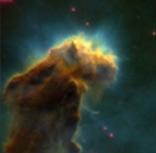Lessons Overview : Optical Astronomy and Its Tools
Optical astronomy is the study of visible light emitted by celestial objects. Optical astronomers use a variety of tools to aid them in their study of the sky, ranging from their unaided eyes, binoculars, and simple telescopes to telescopes as large as a whole building.Some of the largest telescopes on Earth are the two Keck telescopes in Mauna Kea. Often, satellites launched into space will carry some sort of optical equipment. The Hubble Space Telescope is one satellite that carries a great deal of optical equipment. It has taken thousands of high-resolution images from outer space, where it is free from the effects of Earth's atmosphere on visible light.
Keck Telescopes on Mauna Kea

Jean-Charles Cuillandre and the W. M. Keck Observatory

Jean-Charles Cuillandre and the W. M. Keck Observatory
Eagle Nebula (M16)

NASA, ESA, STScI, J. Hester and P. Scowen

NASA, ESA, STScI, J. Hester and P. Scowen